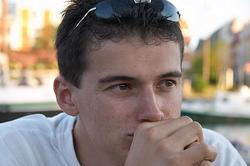Institute of Physics, Felix-Hausdorff-Str. 6, D-17487 Greifswald
 |
Room A303 | |
 |
+49-3834-864772 | |
 |
+49-3834-864701 | |
 |
 |

|
Dr. Gerald Schubert Institute of Physics, Felix-Hausdorff-Str. 6, D-17487 Greifswald
|
 |
Publications |
Curriculum vitae |
Research InterestsThe complete quantum mechanical description of a physical system including all correlation effects is a numerically very demanding task, which permits such an approach only for very small systems. Formulating the full Hamiltonian, it is possible to calculate ground-state properties and spectral quantities via exact diagonalisation techniques and kernel polynomial methods without the need of approximations. If one is interested in the behaviour of larger systems, these purely microscopic descriptions however will fail because of enormous computational requirements. Thus alternative approaches have to be considered. Depending on the focus of interest it is possible to neglect some of the quantum aspects and describe the system by semi-classical methods. Though simplified, they nevertheless yield good results and are widely used in quantum chemistry. If the importance of quantum effects becomes negligible at all, a classical description of the many body system in terms of molecular dynamics or particle-in-cell methods is possible, giving access to even larger systems. During my diploma thesis, I studied disorder effects in solids, such as Anderson localisation, quantum percolation and correlated disorder. Within my PhD-thesis, I focussed on three topics, representative for the above mentioned fields:
Currently I am working the the group for 'High Performance Computing' at the University of Erlangen in a joint project with Greifswald University funded by KONWIHR-II. Besides working on physical topics, such as time-evolution and localisation effects in graphene, I focus on analysing and improving the performance of the underlying numerical algorithms and their implementation. In most of those algorithms the repeated multiplication of a large sparse matrix with a given input vector constitutes the most time consuming part. Therefore any parformance improvement of this operation has a direct impact on the whole application and permits thus the study of larger systems or longer times. Here, especially the nowadays prevailing heterogeneous hardware concepts with multicore-chips and/or accelerator-hardware (general purpose graphics processing units -- GPGPUs) call for specific software designs. Combining 'traditional' MPI-parallelisation between the computing nodes with OpenMP-based intra-node communication and cuda/OpenCl kernels on the GPGPU will be paramount to keep pace with the current trends in hardware development. |